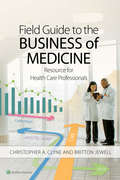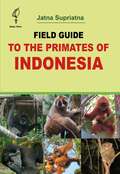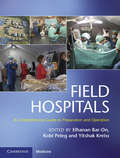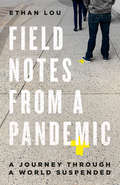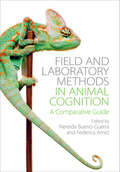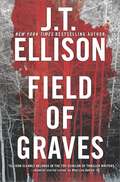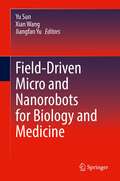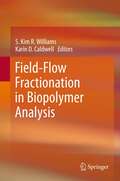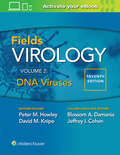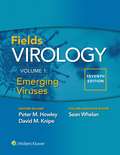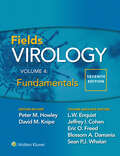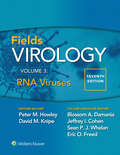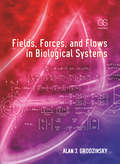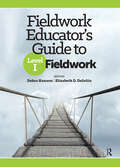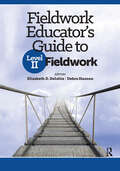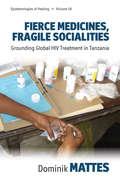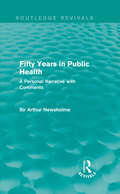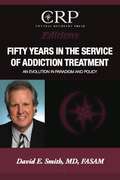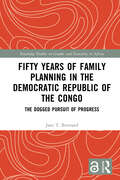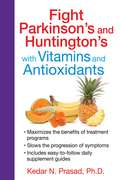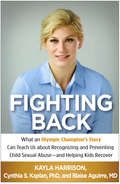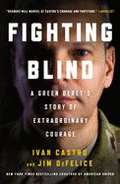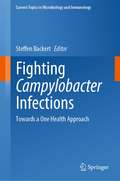- Table View
- List View
Field Guide to the Business of Medicine: Resource for Health Care Professionals
by Christopher Clyne Britton JewellPublisher's Note: Products purchased from 3rd Party sellers are not guaranteed by the Publisher for quality, authenticity, or access to any online entitlements included with the product. Today’s health care is much more than Medicine. Health care professionals and administrators must be familiar with the non-medical aspects of health care if they are to be successful. From the basics of government and private insurance, to reimbursement methods, payment models, practice paradigms and new industry trends this indispensable guide provides much-needed information for medical students and residents, emerging health care professionals, and anyone who wants a clear perspective on the requisites, protocols, and regulations of today’s health care system.
Field Guide to the Primates of Indonesia
by Jatna SupriatnaThis primate field guide can be used to refer to information on each species, or it can be used to find which species exist on each island, as shown at the back of the book. A list of primates in Indonesia is provided with local, English, and scientific names. Once the name is identified the user can go to the description of the genus and species. Also given is the conservation status of each species except for the most recently described, whose status is not yet known. The information on each species' natural history, behavior, ecology, and where to see it in parks and/or forested areas outside parks is included. Field Guide to the Primates of Indonesia primate drawings are by Stephen Nash and photographs were donated by many of the author's friends from Indonesia and abroad.
Field Hospitals: A Comprehensive Guide to Preparation and Operation
by Bar-On Elhanan Kobi Peleg Yitshak KreissField hospitals are deployed in a wide range of scenarios including natural disasters, epidemic outbreaks, armed conflicts and refugee crises. Operation in these conditions requires adaptation to disaster medicine principles and operation in an austere environment and unfamiliar cultural milieu, whilst maintaining acceptable standards of care. For many of those involved it may be their first encounter. This book, which is the first to address the preparation and operation of field hospitals, brings together the experience of world leaders in the field. Coming from a wide variety of organizations and backgrounds, all have extensive experience in field hospital deployment in multiple scenarios. The text - containing both background information and practical guidelines - will serve all those involved in field hospital deployment, including policy makers and planners, physicians and nurses, paramedical professionals and logisticians. It will help them deliver optimal care to people around the globe in difficult times of need.
Field Manual for Small Animal Medicine
by Katherine Polak Ann Therese KommedalField Manual for Small Animal Medicine offers anyone working in resource-limited environments a practical resource for delivering veterinary care outside the traditional hospital or clinic setting. Offers the only comprehensive resource for best practices when practicing veterinary medicine in resource-limited environments Integrates practical and cost-effective protocols where the ideal solution may not be available Presents information on vital topics such as operating a field spay/neuter clinic, emergency sheltering, sanitation and surgical asepsis, preventive care practices, zoonotic diseases, and euthanasia Serves as a quick reference guide for common surgical procedures, cytology interpretation, anesthesia and treatment protocols, and drug dosing The only comprehensive resource for practicing in resource-limited environments Integrates practical protocols for handling medical operations Coverage includes animal capture and transport, surgical operations, temporary sheltering, diagnostic techniques, medical and treatment protocols, euthanasia practices, and triage
Field Notes from a Pandemic: A Journey Through a World Suspended
by Ethan LouEqual parts travelogue and pandemic guide, journalist Ethan Lou examines the societal effects of COVID-19 and takes us on a mesmerizing journey around a world that will never be the same.Visiting Beijing in January to see his dying grandfather, Canadian journalist Ethan Lou unknowingly walks into a state under siege. In his journey out of China and into other hot zones in Asia and Europe, he finds himself witnessing the very earliest stages of a virus that will forever change the world as we know it. Lou argues that Coronavirus will have a far greater impact than SARS, for example, simply because China is now many more times integrated with the increasingly interconnected world. Over decades, globalization has crafted a world painfully sensitive and susceptible to shocks such as this pandemic. A crisis like it has thus been long overdue--and we have yet to see it unfold fully. In our integrated world, events that may previously be isolated now ripple farther and wider and in ways we do not expect and cannot foresee. We have not seen the worst, and if and when we outlast this pandemic, nothing will ever be the same--not just healthcare systems but also economies, politics and culture. Decisions now--or indecisions--will shape and define the world for decades.These ideas are fleshed out through the virus's spawning and how it spread, the unprecedented measures to contain it and an examination of past pandemics and other crises and how they shaped the world--and an argument for why this one's different. Lou shows how drastically the virus has transformed the world and charts the greater and more radical shifts to come. His ideas and arguments are framed around his journey around the world, whose path the virus seemed to follow until he landed safely in quarantine in a small town in Germany where he was able to take stock and start telling his story.
Field and Laboratory Methods in Animal Cognition: A Comparative Guide
by Nereida Bueno-Guerra Federica AmiciWould you ask a honeybee to point at a screen and recognise a facial expression? Or ask an elephant to climb a tree? While humans and non-human species may inhabit the same world, it's likely that our perceptual worlds differ significantly. Emphasising Uexküll's concept of 'umwelt', this volume offers practical advice on how animal cognition can be successfully tested while avoiding anthropomorphic conclusions. The chapters describe the capabilities of a range of animals - from ants, to lizards to chimpanzees - revealing how to successfully investigate animal cognition across a variety of taxa. The book features contributions from leading cognition researchers, each offering a series of examples and practical tips drawn from their own experience. Together, the authors synthesise information on current field and laboratory methods, providing researchers and graduate students with methodological advice on how to formulate research questions, design experiments and adapt studies to different taxa.
Field of Graves: A Thrilling suspense novel (A Taylor Jackson Novel #Null)
by J. T. EllisonWith FIELD OF GRAVES, New York Times bestselling author J.T. Ellison goes back to where it all began... All of Nashville is on edge with a serial killer on the loose. A madman is trying to create his own end-of-days apocalypse and the cops trying to catch him are almost as damaged as the killer. Field of Graves reveals the origins of some of J.T. Ellison's most famous creations: the haunted Lieutenant Taylor Jackson; her blunt, exceptional best friend, medical examiner Dr. Samantha Owens; and troubled FBI profiler Dr. John Baldwin. Together, they race the clock and their own demons to find the killer before he claims yet another victim. This dark, thrilling and utterly compelling novel will have readers on the edge of their seats, and Ellison's fans will be delighted with the revelations about their favorite characters.
Field-Driven Micro and Nanorobots for Biology and Medicine
by Yu Sun Xian Wang Jiangfan YuThis book describes the substantial progress recently made in the development of micro and nanorobotic systems, utilizing magnetic, optical, acoustic, electrical, and other actuation fields. It covers several areas of micro and nanorobotics including robotics, materials science, and biomedical engineering. Field-Driven Micro and Nanorobots for Biology and Medicine provides readers with fundamental physics at the micro and nano scales, state-of-the-art technical advances in field-driven micro and nanorobots, and applications in biological and biomedical disciplines.
Field-Flow Fractionation in Biopolymer Analysis
by S. Kim Williams Karin D. CaldwellThis is a timely collection of important biomedical applications for a set of separation/characterization techniques that are rapidly gaining popularity due to their wide dynamic range, high resolution, and ability to function in most commonly used solvent systems. Importantly, the field-flow fractionation (FFF) technique has recently emerged as a prominent complement to size exclusion chromatography for protein pharmaceuticals. Fractionation with FFF is gentle and preserves protein structural integrity better than existing alternatives. In the present text, different chapters are written by experts in their respective field of application, who offer comparisons between the FFF techniques and other methods for characterizing their special focus material. Practical guide-lines for successful implementation, such as choice of operating conditions, are offered in conjunction with each application. In addition to new instrumentation and approaches that address important current topics, readers are provided with an overall sense of prior (but timeless) major developments that may be overlooked in literature searches.
Fields Virology: DNA Viruses
by Jeffrey L. Cohen Peter M. Howley David M. Knipe Blossom A. DamaniaBundled with the eBook, which will be updated regularly as new information about each virus is available, this text serves as the authoritative, up-to-date reference book for virologists, infectious disease specialists, microbiologists, and physicians, as well as medical students pursuing a career in infectious diseases.
Fields Virology: Emerging Viruses
by Peter M. Howley David M. KnipeNow in four convenient volumes, Field’s Virology remains the most authoritative reference in this fast-changing field, providing definitive coverage of virology, including virus biology as well as replication and medical aspects of specific virus families. This volume of Field’s Virology: Emerging Viruses, 7th Edition covers recent changes in emerging viruses, providing new or extensively revised chapters that reflect these advances in this dynamic field.
Fields Virology: Fundamentals
by Peter M Howley David M Knipe Lynn W EnquistNow in four convenient volumes, Field’s Virology remains the most authoritative reference in this fast-changing field, providing definitive coverage of virology, including virus biology as well as replication and medical aspects of specific virus families.
Fields Virology: RNA Viruses
by Eric O. Freed Peter M. Howley David M. Knipe Sean WhelanNow in four convenient volumes, Field’s Virology remains the most authoritative reference in this fast-changing field, providing definitive coverage of virology, including virus biology as well as replication and medical aspects of specific virus families. This volume of Field’s Virology: RNA Viruses, Seventh Edition covers the latest information on RNA viruses, how they cause disease, how they can cause epidemics and pandemics, new therapeutics and vaccine approaches, as provided in new or extensively revised chapters that reflect these advances in this dynamic field. Bundled with the eBook, which will be updated regularly as new information about each virus is available, this text serves as the authoritative, up-to-date reference book for virologists, infectious disease specialists, microbiologists, and physicians, as well as medical students pursuing a career in infectious diseases.
Fields, Forces, and Flows in Biological Systems
by Alan J GrodzinskyFields, Forces, and Flows in Biological Systems describes the fundamental driving forces for mass transport, electric current, and fluid flow as they apply to the biology and biophysics of molecules, cells, tissues, and organs. Basic mathematical and engineering tools are presented in the context of biology and physiology.The chapters are structured in a framework that moves across length scales from molecules to membranes to tissues. Examples throughout the text deal with applications involving specific biological tissues, cells, and macromolecules. In addition, a variety of applications focus on sensors, actuators, diagnostics, and microphysical measurement devices (e.g., bioMEMs/NEMs microfluidic devices) in which transport and electrokinetic interactions are critical.This textbook is written for advanced undergraduate and graduate students in biological and biomedical engineering and will be a valuable resource for interdisciplinary researchers including biophysicists, physical chemists, materials scientists, and chemical, electrical, and mechanical engineers seeking a common language on the subject.
Fieldwork Educator’s Guide to Level I Fieldwork
by Debra Hanson Elizabeth DeIuliisA new resource for occupational therapy academic fieldwork coordinators and fieldwork educators, Fieldwork Educator’s Guide to Level I Fieldwork is a practical guide for faculty and clinicians to design and implement Level I fieldwork experiences for occupational therapy and occupational therapy assistant students.Fieldwork Educator’s Guide to Level I Fieldwork was designed to address the challenges of integrating Level I fieldwork with classroom learning experiences. Expansive and versatile, the book meets the recently expanded definition of Level I fieldwork according to the 2018 Accreditation Council for Occupational Therapy Education standards, including faculty-led experiences, standardized patients, simulation, and supervision by a fieldwork educator in a practice environment.Each unit of the text builds upon the previous unit. The first unit provides fundamental knowledge on experiential learning and includes an orientation to the purpose of Level I fieldwork in occupational therapy. Building on this foundation, the second unit equips the reader with resources to develop a Level I fieldwork learning plan suitable for their setting. The final units focus on situational scenarios that emerge during Level I fieldwork placements and provides a framework for assessing student learning during Level I fieldwork. While each chapter is designed to build upon one another, they also can be used as stand-alone resources depending on the needs of the reader.What is included in Fieldwork Educator’s Guide to Level I Fieldwork: Up-to-date terminology Experiential learning frameworks and models in diverse contexts, including role emerging and simulation Strategies for addressing anxiety and student stress management and supporting students with disabilities Models to support clinical reasoning development during Level I fieldwork Mechanisms to foster student professional development and communication skills Be sure to also look into the successive textbook, Fieldwork Educator’s Guide to Level II Fieldwork, which was designed in-tandem with this book to be a progressive resource that exclusively focuses on Level II fieldwork.
Fieldwork Educator’s Guide to Level II Fieldwork
by Debra Hanson Elizabeth DeIuliisA new, comprehensive resource for fieldwork educators and academic fieldwork coordinators, Fieldwork Educator’s Guide to Level II Fieldwork provides a blueprint for designing, implementing, and managing Level II fieldwork programs for occupational therapy and occupational therapy assistant students across practice settings.Drawing from the expertise of renowned individuals in the field, Drs. Elizabeth D. DeIuliis and Debra Hanson provide the tools for fieldwork educators and academic fieldwork coordinators to put together learning frameworks, educational theories, and clinical instructional techniques within and outside occupational therapy in order to create and maintain high-quality Level II learning experiences. Fieldwork Educator’s Guide to Level II Fieldwork challenges fieldwork educators and academic fieldwork coordinators to shift their mindset to facilitating skill acquisition and to adjust their teaching approach to match the learning needs and developmental level of the student.Designed to meet the definition of Level II fieldwork according to the 2018 Accreditation Council for Occupational Therapy Education standards, and in response to common pitfalls and challenges in clinical education today, Fieldwork Educator’s Guide to Level II Fieldwork is the go-to guide for the busy practitioner and academic fieldwork coordinator.What is included in Fieldwork Educator’s Guide to Level II Fieldwork: Expansive overviews of supervision models and vignettes illustrating use across practice settings Examples and templates to construct a learning plan, site-specific learning objectives, orientation, weekly schedules, and learning contracts Tools and strategies to uniquely develop and foster clinical reasoning in fieldwork Models for dually approaching supervision and mentorship Strategies for addressing unique student learning and supervision needs Fieldwork Educator’s Guide to Level II Fieldwork can be used as a standalone resource or as a complement to Fieldwork Educator’sGuide to Level I Fieldwork, which was designed in-tandem with this text to holistically address Levels I and II fieldwork education
Fierce Medicines, Fragile Socialities: Grounding Global HIV Treatment in Tanzania (Epistemologies of Healing #18)
by Dominik MattesSet in Tanga, a city on the Tanzanian Swahili coast, Dominik Mattes examines the implementation of antiretroviral HIV-treatment (ART) in the area, exploring the manifold infrastructural and social fragilities of treatment provision in public HIV clinics as well as patients’ multi-layered struggles of coming to terms with ART in their everyday lives. Based on extensive ethnographic fieldwork, the book shows that, notwithstanding the massive rollout of ART, providing treatment and living a life with HIV in settings like Tanga continue to entail social, economic, and moral challenges and long-term uncertainties, which contradict the global rhetoric of the “normalization of HIV”.
Fierce Medicines, Fragile Socialities: Grounding Global HIV Treatment in Tanzania (Epistemologies of Healing #18)
by Dominik MattesSet in Tanga, a city on the Tanzanian Swahili coast, Dominik Mattes examines the implementation of antiretroviral HIV-treatment (ART) in the area, exploring the manifold infrastructural and social fragilities of treatment provision in public HIV clinics as well as patients’ multi-layered struggles of coming to terms with ART in their everyday lives. Based on extensive ethnographic fieldwork, the book shows that, notwithstanding the massive rollout of ART, providing treatment and living a life with HIV in settings like Tanga continue to entail social, economic, and moral challenges and long-term uncertainties, which contradict the global rhetoric of the “normalization of HIV”.
Fifty Years in Public Health: A Personal Narrative with Comments (Routledge Revivals)
by Sir Arthur NewsholmeFirst published in 1935, this book provides a valuable contribution to the history of Public Health and Preventive Medicine. Written as a recollection of the experiences and knowledge of Sir Arthur Newsholme, the book covers a period in which phenomenal progress was made.
Fifty Years in the Service of Addiction Treatment
by David E. SmithWe live in a time where treatment of addiction is transitioning from being criminalized to being medicalized. We begin a new era where it will be addressed like other chronic, incurable, and potentially fatal medical conditions. The 2012 US Supreme Court decision on healthcare reform providing parity for addiction and mental health treatment is an important part of this process.
Fifty Years of Family Planning in the Democratic Republic of the Congo: The Dogged Pursuit of Progress (Routledge Studies on Gender and Sexuality in Africa)
by Jane T. BertrandThis book chronicles five decades of struggle to introduce family planning into one of the largest, most complex countries in sub-Saharan Africa: the Democratic Republic of the Congo (DRC).Interweaving details of major political, social, and economic events into the history of family planning in DRC (formerly Zaïre), the book analyses the achievements and setbacks of five decades of programmatic work. President Mobutu’s 1972 discourse on Naissances Désirables (desirable births) opened the door to organized family planning programs, which gained considerable momentum in the 1980s despite societal norms favoring large families. Two pillages and armed conflict paralyzed development work during the decade of the 1990s, and family planning was one of multiple public health programs that struggled to regain lost ground in the 2000s. With new donor funding and implementing agencies, the 2010s witnessed rapid programmatic expansion and improved strategies. By 2018, family planning was operating as a well-oiled machine. But progress is fragile. The book ends by tracing the deleterious effects of the colonial period to contemporary programming and individual contraceptive use. It asks hard questions about donor financing. And it details the six conditions needed to accelerate family planning progress in the DRC, in pursuit of providing millions of Congolese women and men with the means of controlling their own fertility.The book will be of interest to development and public health researchers and practitioners, as well as to historians of the Democratic Republic of the Congo.
Fight Parkinson's and Huntington's with Vitamins and Antioxidants
by Kedar N. PrasadThe most up-to-date resource on the powerful benefits of nutritional supplements for the treatment of Parkinson’s and Huntington’s disease• Provides an easy-to-follow program of supplements to optimize the benefits of treatment, slow the progression of symptoms, and help delay onset in those predisposed to these diseases• Shows how specific combinations of antioxidants counteract the oxidative stress and chronic inflammation at the root of these diseases• Based on more than 35 years of scientific and medical researchIn this practical scientific guide, micronutrient researcher Kedar N. Prasad, Ph.D., reveals the latest revolutionary discoveries on the use of antioxidants to treat Parkinson’s and Huntington’s disease. He details how the proper combinations of vitamin and antioxidant supplements, along with polyphenic compounds such as curcumin and resveratrol, can greatly increase the effectiveness of standard medical treatments for these diseases, slowing the progression of symptoms as well as delaying onset despite family history.Prasad shows how oxidative stress and chronic inflammation play a significant role in the initiation and progression of neurodegenerative diseases like Parkinson’s and Huntington’s disease. He provides an easy-to-follow daily supplement regimen to target free-radical damage and inflammation and slow the progression of these diseases. Reviewing the scientific research on micronutrients and neurodegenerative disease, he debunks the flawed conclusions of the neurological community that vitamins and antioxidants are ineffective, revealing how their studies focused on specific micronutrients used alone rather than synergistic combinations.Offering a safe self-help complement to standard medications, this guide provides a truly holistic approach to the prevention and treatment of both Parkinson’s and Huntington’s disease.
Fighting Back: What an Olympic Champion's Story Can Teach Us about Recognizing and Preventing Child Sexual Abuse--and Helping Kids Recover
by Kayla Harrison Cynthia S. Kaplan Blaise AguirreTwo-time Olympic gold medalist Kayla Harrison has always been a fighter--yet as a young teen, no one knew she was also a victim. Combining Kayla's powerful story of sexual abuse by her judo coach with science-based information from two renowned therapists, this unique book provides critical guidance for parents and professionals. Learn how to spot the signs that a child or teen is being groomed, why kids stay silent about their trauma, how they struggle with self-blame and the brutal betrayal of a trusted authority figure, and exactly what kind of help they need to recover. No one is more qualified than Kayla and her expert coauthors to explain the impact of child sexual abuse--and what you can do to keep kids safe.
Fighting Blind: A Green Beret's Story Of Extraordinary Courage
by Jim DeFelice Ivan Castro Ivan Castro and Jim DeFeliceFighting was a practiced routine for Lieutenant Ivan Castro. But when a mortar round struck the rooftop of his sniper’s post in Iraq, he found himself in a battle more difficult than even he could have imagined. The direct hit killed two other soldiers and nearly claimed Castro’s life as well. Mangled by shrapnel and badly burned, Castro was medevac’d to Germany more dead than alive. His lungs were collapsed. He couldn’t hear. One eye had been blown out, the nerve to the other severed. In the weeks and months that followed, Castro would find that physical darkness was nothing compared to the emotional darkness of loss and despair. Desperate for a reason to live, he eventually fought his way back to health through exercise and a single-minded goal: running a marathon. Once he set his course, there was no stopping him. Stubborn to a point that at times bordered on insanity, he managed not only to recover but to return to active duty. Since 2007, he has run over two dozen marathons, including the Boston Marathon in 2013, where he was one of the runners diverted when the bombs exploded. Today, Castro helps prepare soldiers for combat, working exactly as if he were “sighted.” Fighting Blind, this frankly told account of his struggle through adversity, the highs and lows and the always bumpy road in between, is a story of hope and perseverance against the odds: an Unbroken for the present generation.
Fighting Campylobacter Infections: Towards a One Health Approach (Current Topics in Microbiology and Immunology #431)
by Steffen BackertThis edited volume explores Campylobacter species, which are some of the most important foodborne pathogens. Above all, contaminated poultry meat can cause human gastroenteritis in both developed and developing countries. The respective contributions reveal how these infections can also increase the risk of generalized paralytic diseases such as Guillain-Barré syndrome, Miller-Fisher syndrome, and Chinese paralytic syndrome. Due to their influence on the nervous system, circulatory system, and various organs, Campylobacter infections represent a serious public health concern.Campylobacter can be effectively combated by addressing the hygienic conditions in both food production and human lifestyles. Accordingly, the authors put forward a One Health perspective, which provides readers with essential insights into the basic biology of Campylobacter, as well as practical guidance on aspects ranging from food production to the clinical treatment of infections.Chapter 'Natural Competence and Horizontal Gene Transfer in Campylobacter’ is available open access under a Creative Commons Attribution 4.0 International License via link.springer.com.
